Fault
1800 898 220

AGN owns and operates the gas distribution network in South Australia. Retailers use our network to transport gas to homes and small businesses in the community.
Hydrogen Park South Australia (HyP SA) is our first renewable gas project, delivered with support funding from the South Australian Government's Renewable Technology Fund and located within the Tonsley Innovation District..

Since May 2021 we have produced renewable hydrogen using renewable electricity and water, suppling to more than 700 homes near HyP SA a blend of up to 5% (by volume) renewable hydrogen in natural gas, delivered through the existing gas network.
In March 2023, AGN expanded the HyP SA network delivering an up to 5% (by volume) renewable gas blend to a further 3,000 additional customers in Mitchell Park, Clovelly Park and parts of Marion – including households, businesses, and schools.
In March 2024, blending was increased from an up to 5% (by volume) renewable gas blend, to an up to 10% (by volume) renewable gas blend.
In addition to supplying the networks, AGN is actively exploring the supply of renewable hydrogen to transport and industrial sectors. In August 2022, AGN announced operational commencement of HyP SA’s supply to parts of the Whyalla Steelworks in South Australia, delivered by road by tube trailer as part of a partnership with BOC, a Linde Company.
Renewable hydrogen can be used in the same way as natural gas, heating homes and businesses, generating electricity and as a transport fuel. Yet it doesn’t produce any carbon emissions – only water and energy.
Hydrogen production at Hydrogen Park South Australia Video
Renewable hydrogen is produced at our Hydrogen Park South Australia (HyP SA) at the Tonsley Innovation District.
Hydrogen is the most abundant molecule in the universe, however it’s not freely available - it must be separated from other elements, typically oxygen as water. The hydrogen we produce at HyP SA is renewable because it is created from water and renewable electricity in a process called electrolysis and produces zero carbon emissions in the entire process.
At HyP SA, the renewable hydrogen is:
The oxygen produced as a biproduct of making hydrogen is released into the atmosphere.

Fast facts
| Online | May 2021 |
| Electrolyser | 1.25MW Proton Exchange Membrane (PEM) |
| Production | Up to 20kg per hour |
| Storage | 40kg onsite |
| Electricity | Renewable electricity via grid* |
| Water | 15L of ultrapure water for 1kg of hydrogen** |
| Markets | Up to 10% (volume) renewable gas blend to more than 3700 connections, businesses and schools and 100% to industry via tube trailers |
* AGN purchases (and voluntarily surrenders) Large Scale Generation Certificates as required to ensure the electricity used to produce hydrogen is renewable.
** For context, in South Australia, the average person uses 190L of water per day. Running the HyP SA facility for 1 hour is the equivalent of a 30 minute shower with a low flow showerhead.

HyP SA has received a number of accolades in recognition of its role demonstrating the pathway to a cleaner energy future, including:
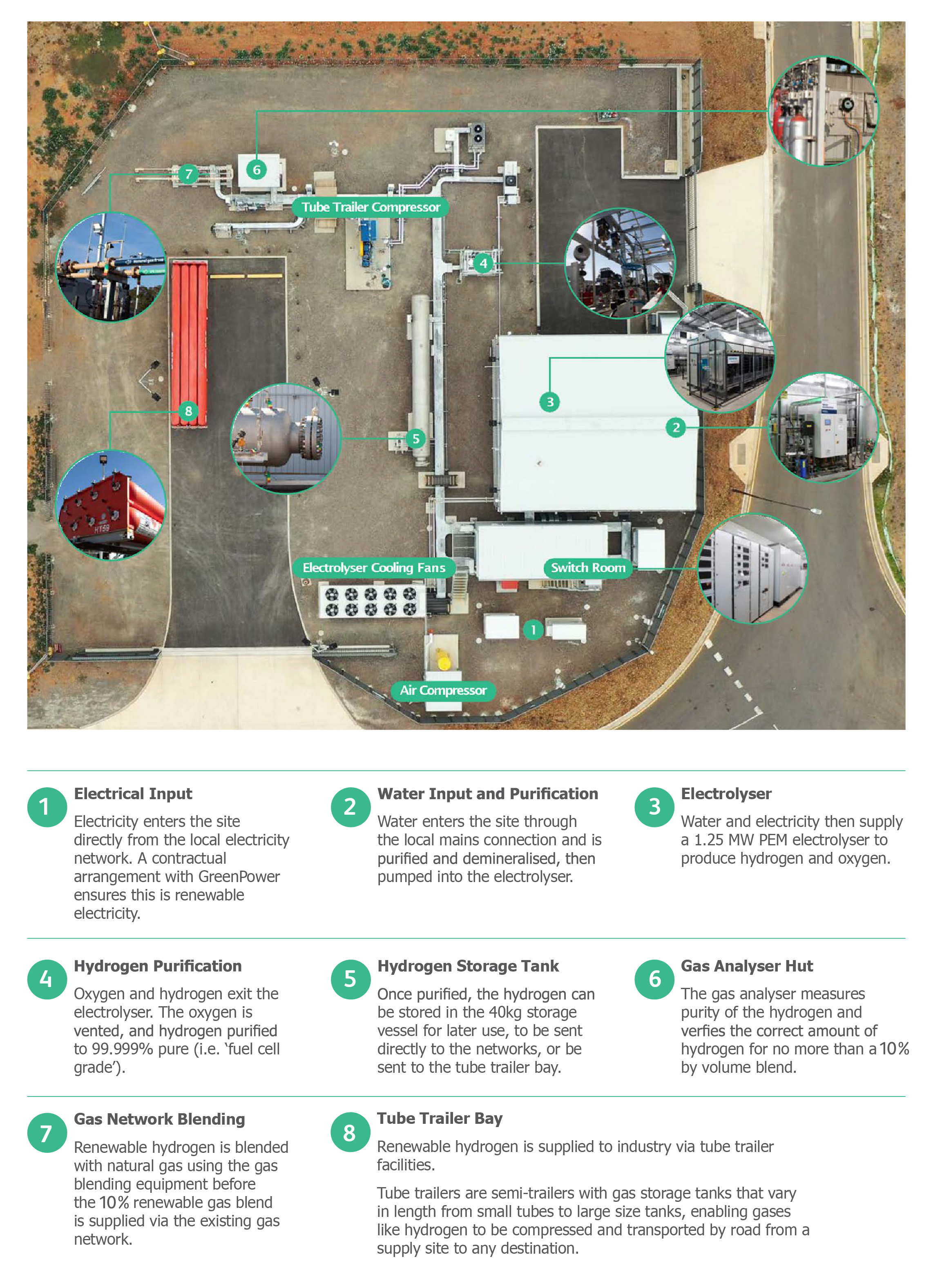
Additional information such as our carbon strategy, project downloads, videos and events can be found on our News and Resources page.
At AGN we are committed to delivering for our customers today and tomorrow. We are targeting 10% renewable gas across our networks by 2030 and conversion to 100% renewable gas by no later than 2050 – and by 2040 as our stretch target. You can learn more about our plans here.
Renewable gas is not only key to decarbonise homes and businesses but can also be used in vehicles, industry and as a way to export our sun and wind resources.
We are actively pursuing additional hydrogen projects with a view to blending more hydrogen into our Australian networks.
Australia is working towards a reduction in carbon dioxide (CO2), by 43% below 2005 levels by 2030 and South Australia is working towards becoming net zero emissions by 2050.
AGN is reducing its carbon emissions, leading the transition of natural gas networks to renewable gas, starting with an up to 5% (by volume) renewable hydrogen blend to Mitchell Park in South Australia. In early 2023, this area was extended to include an additional 3,000 customers in Mitchell Park, Clovelly Park and parts of Marion – including households, businesses, and schools. The renewable hydrogen blend was then increased from up to 5% to up to 10% (by volume) in March 2024.
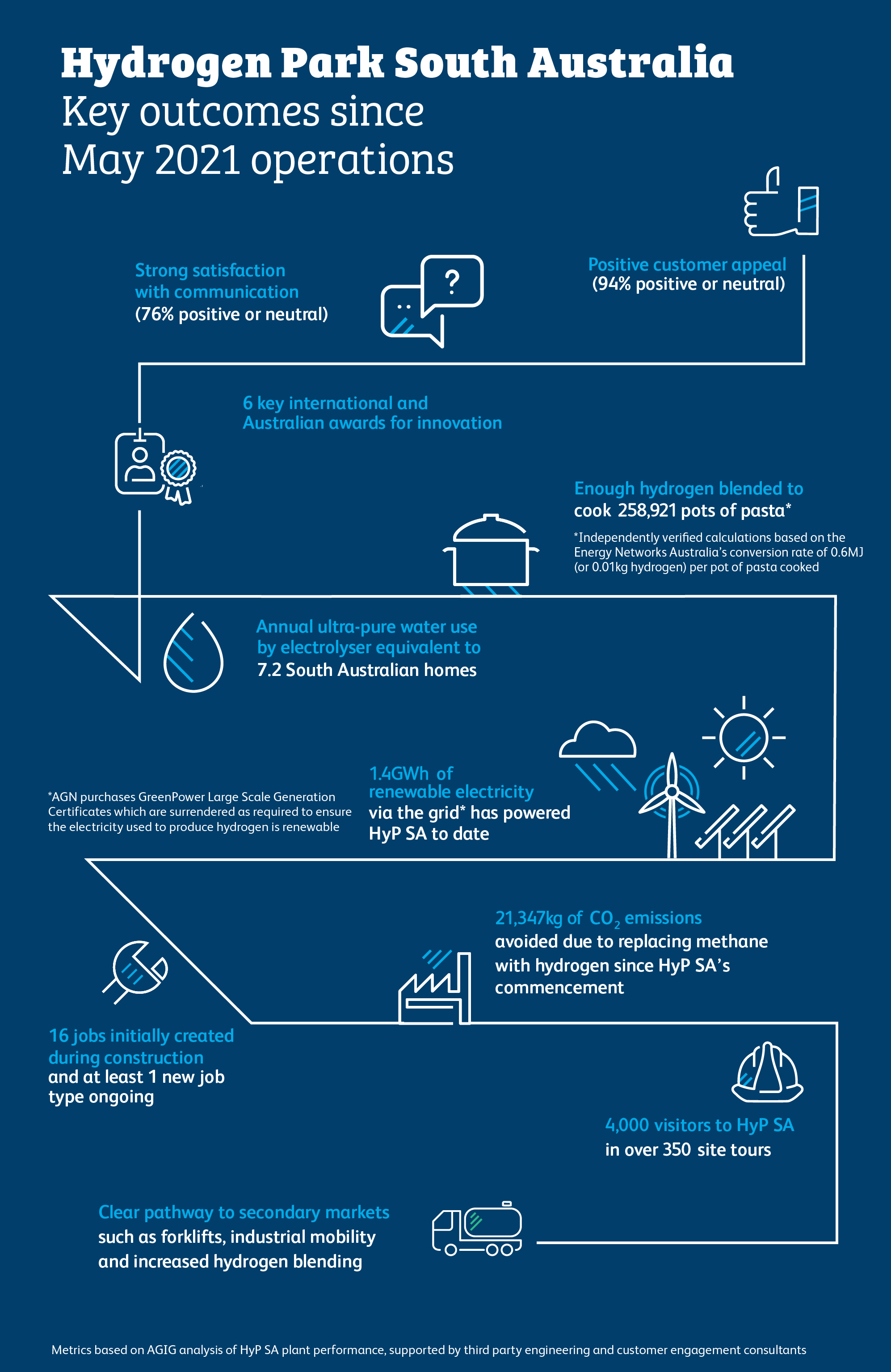
Today Australia’s energy system relies on diverse sources of energy – natural gas and liquid fuels (petrol and diesel) are used for more than double the energy provided by electricity. As we move towards net zero emissions, maintaining diverse sources of energy can help with energy security, reliability and affordability.
Unlike natural gas or petrol, when hydrogen is burned there are no CO2 emissions. Just like natural gas, hydrogen can be used for:
Modelling indicates that decarbonising natural gas through renewable hydrogen can be as cost competitive as electrification as it avoids significant investment in additional electricity infrastructure such as poles, wires and additional batteries. It also means customers retain their choice of energy supply, and those industries relying on gas can continue to access it.
Hydrogen also has other benefits such as:
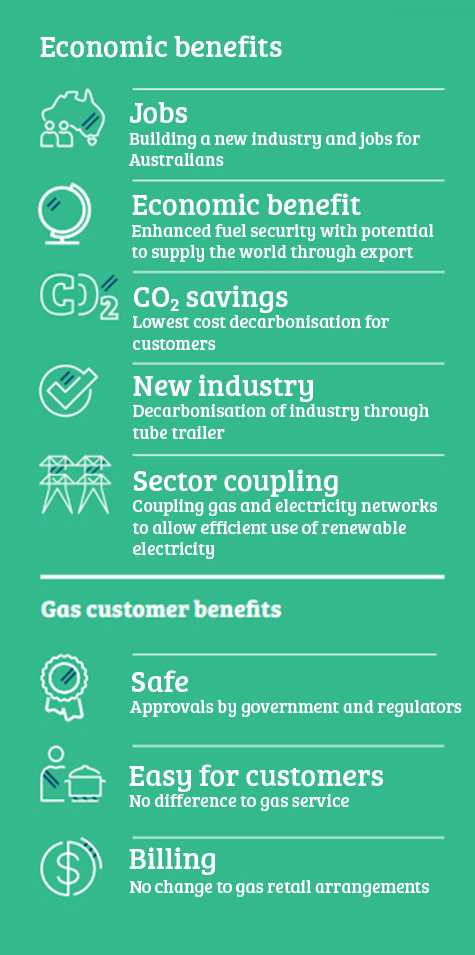
An up to 10% (by volume) renewable hydrogen blend is the first step to lowering carbon emissions but we are pursuing more projects, aiming to blend up to 10% renewable hydrogen in South Australia and across the other regions we serve by 2030 and before 100% conversion by 2050.
AGN recently led the Australian Hydrogen Centre (AHC) Australian-first feasibility studies of how existing natural gas distribution networks could be used in a system to produce, store, and transport renewable hydrogen, decarbonising gas supply while still meeting the needs of millions of customers.
This Summary Report presents the key findings from a series of technical reports.
1. 10% Hydrogen Distribution Networks in selected Regional Towns in Victoria and South Australia.
2. 10% Hydrogen Distribution Networks – Victorian and South Australian Feasibility Studies.
3. 100% Hydrogen Distribution Networks – Victorian and South Australian Feasibility Studies.
The $4.15 million AHC project, supported by the Australian Renewable Energy Agency (ARENA), the Victorian Government and the South Australian Government, has brought together expertise and knowledge from across the energy supply chain including renewable electricity producers, electricity and gas infrastructure owners, and retailers to produce comprehensive research.
This follows the Australian National Hydrogen Strategy’s (the Strategy) identification of hydrogen in gas networks as one of three large-scale activation markets to build demand. The Strategy outlined that taking early steps to use hydrogen in transport, industrial use and gas networks will complement and enhance the impact of hydrogen hubs on making hydrogen infrastructure more cost-effective, promoting efficiencies, fostering innovation, and encouraging sector coupling synergies.
These studies have found that achieving 10% hydrogen blending helps lay the foundations for Australia’s emerging hydrogen industry through development of skills, public acceptance and large-scale projects while lowering emissions and retaining energy affordability and reliability.
Key features of the transition include:
For more information on these feasibility studies, please visit ARENA’s Knowledge Bank
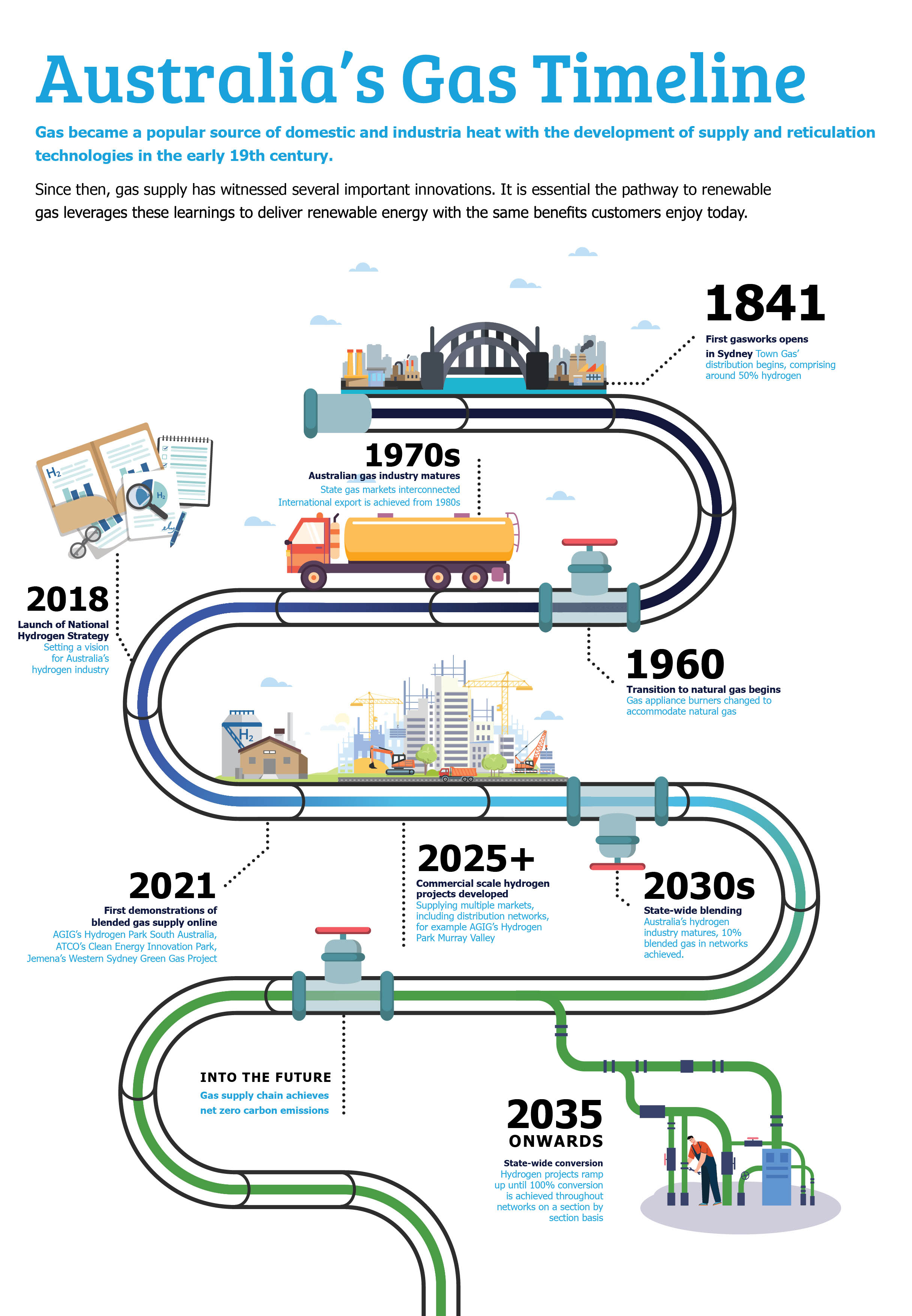
Customers in Mitchell Park, south of Alawoona Ave: in the area bounded by Alawoona Avenue, the railway line, Sturt Creek and Sturt Road, have been receiving blended gas since May 2021.
In early 2023 AGN extended the project area to include a further 3,000 additional customers in Mitchell Park, Clovelly Park and parts of Marion – including households, businesses, and schools.
You can see which houses are included in the map below. If you are unsure, please contact us.
Customers won't notice any change to the gas, or the price they pay to their energy retailer. It's also as safe as the current natural gas supply.
Hydrogen has a lower heating value than natural gas, this means hydrogen carries slightly less energy for the same volume. As a result, people in this demonstration will need a slightly higher volume of blended gas to provide the same amount of energy compared to using natural gas.
At AGN, we make a billing adjustment to ensure customers do not have to pay more than if they were using natural gas.
If you have questions about your billing that haven't been answered here, contact us.
Our gas network is made of polyethylene and are suitable for transporting a hydrogen blended gas.
Your appliances will continue to work safely and reliably on this of renewable gas.
The characteristics of the blended gas supplied as part of this project are consistent with those set out for natural gas within the Australian Standard.
Any appliances sold in Australia are subject to testing to ensure they work safely and reliably with natural gas. They are tested with varying gas compositions to account for the varying sources of natural gas supplied around Australia. One of these “limit” gas compositions already contains 13% hydrogen, and therefore all certified household gas appliances sold in Australia have undergone a range of safety tests with this level of hydrogen.
There has been extensive research and several projects in Australia and overseas in relation to the blending of hydrogen with natural gas and its use in appliances.
"Hydrogen can be safely added to natural gas supplies at 10% by volume without changes to pipelines, appliances or regulations. Over time, and with modifications to the existing gas networks and appliances, hydrogen can completely replace natural gas for domestic cooking, heating and hot water." A report for the Council of Australian Governments (COAG)
We are experts in developing and operating gas infrastructure safely and reliably. This is our commitment to the more than one million Australians we serve. Our commitment to safety underpins everything we do, and we are satisfied that an up to 10% (by volume) renewable hydrogen blend with natural gas is as safe as 100% natural gas. This is based on:
At AGN we’re subject to regulation by government bodies, which are designed to ensure our commitment to safety, reliability and service continue.
Hydrogen, like other fuels, is flammable and this is a key reason it can provide us with energy. It also means we need to treat hydrogen and blended gas with respect, as we do natural gas, electricity, petrol and other energy carriers.
Blending 10% renewable hydrogen won’t change the approach to safety that is currently in place. The blended 10% renewable gas will still retain the distinctive natural gas smell that allows you to detect any leak.
You should continue to follow the same safety principles you do with your natural gas supply, ensuring you appliances are installed correctly and maintained. Importantly, if you ever smell gas or think there is a leak, you should report it.
From 1861 until 1969, South Australia relied upon Town Gas to meet demand. Towns Gas was gas manufactured from coal and consisted of 50-60% hydrogen. Some places such as Hong Kong and Singapore still rely on Town Gas.
We switched from Town Gas upon the discovery of natural gas, because at the time natural gas was considered more reliable and economic. Today, the costs of producing hydrogen are coming down, and we know that blended gas is the first step on our journey to lowering carbon emissions.
If you ever smell gas in the street or on your property before or including your gas meter you should call our Leaks and Emergency Services on 1800 GAS LEAK (1800 427 532) to locate and repair the leak.
If you think the leak is after the meter on a section of pipe work connecting your appliances, or on the appliance itself, you should contact a licensed gas fitter to fix the problem. Remember, any person undertaking work involving gas must be appropriately licensed.
Learn more about safety and gas appliances.
If you have questions about safety that haven't been answered here, please read our Fact Sheet FAQs or contact us.
Hydrogen Park South Australia has taken a phased approach with each stage featuring key progress indicators. To keep you updated on the latest activity from around the HyP SA grounds, please see an outline of significant progress below:
HyP SA has been widely recognised for its innovation with the following awards:
March 2024
In March 2024, HyP SA increased its supply of renewable blended gas into the gas network (Mitchell Park, Clovelly Park and parts of Marion) – from up to 5% to up to 10% (by volume).
Increasing the volume of blended renewable gas to up to 10% is helping to further reduce carbon emissions and goes toward achieving our vision of 10% renewable gas blending in all our gas networks by 2030.

August 2023
In August 2023, the South Australian Government announced a two-year hydrogen bus trial involving two vehicles based at the Morphettville bus depot deployed on routes across Adelaide from late August. The hydrogen fuel for the bus trial will be supplied by BOC with offtake from the HyP SA facility.

March 2023
In March 2023, AGN expanded the HyP SA network delivering a 5% renewable gas blend to area to a further 3,000 additional customers in Mitchell Park, Clovelly Park and parts of Marion – including households, businesses, and schools.
December 2022
HyP SA has been named the winner of the ‘Community Engagement’category at the 2022 South Australian Premiers Awards.
AGIG Chief Executive Officer, Mr Craig de Laine, said: “AGIG is very proud and honoured to have been recognised for this award from the South Australia Premier Peter Malinauskas. It is a great recognition of the work our team does in engaging with the communities we serve.
“We thank the community and industry stakeholders associated with HyP SA for their support and participation of our engagement program.”
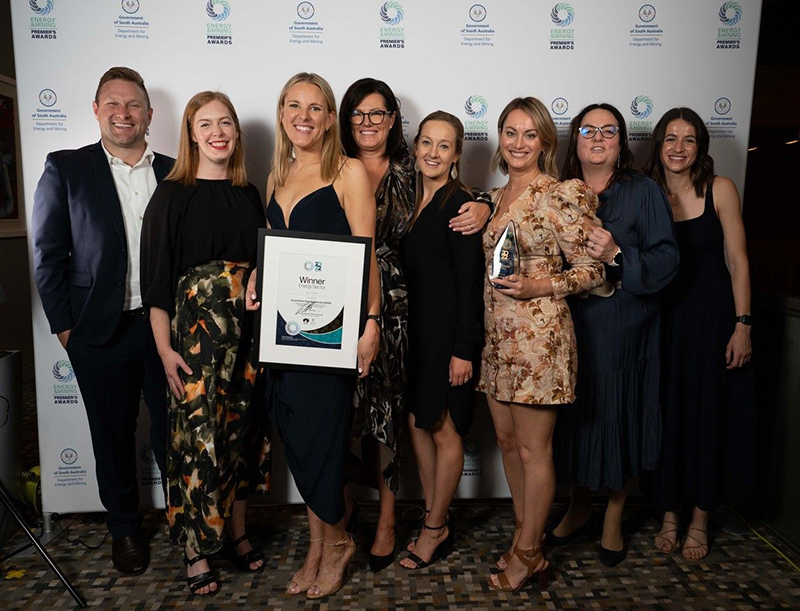
October 2022
The signing of an agreement with BOC Ltd, a subsidiary of Linde plc, was announced to install tube trailer refilling infrastructure at the site.
Hydrogen tube trailers are generally semi-trailers with hydrogen tanks that vary in length from small tubes to very large size tanks – enabling hydrogen to be road-hauled from a supply site to any destination.
BOC plans to supply industrial customers in Whyalla and Adelaide with hydrogen output from HyP SA.
The new Adelaide-based hydrogen supply chain will replace current tube trailer hydrogen deliveries to Whyalla from Victoria, saving approximately 117,000km in annual driving and 122,000 kilograms of carbon emissions per year.
In August 2022, AGN announced operational commencement of HyP SA’s supply to parts of the Whyalla Steelworks in South Australia, delivered by road by tube trailer as part of a partnership with BOC, a Linde Company.
May 2021
HyP SA has been widely recognised for its innovation with the following awards:
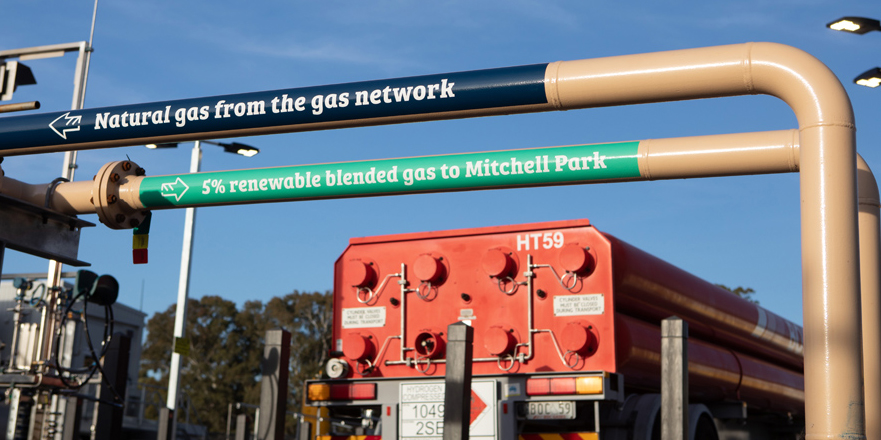
February 2021
HyP SA has been named the winner of the ‘Business and Industry’ category at the 2020 SA Climate Leaders Awards. Judges from the Premier’s Climate Change Council said HyP SA is “incredibly important for South Australia, reaffirming the state as a leader in renewable energy innovation and development”. The judges also recognised the engagement and collaboration undertaken as part of the project.
The bi-annual awards were held earlier this year and attended by a number of industry leaders, including South Australia’s Minister for Environment and Water, the Honourable David Speirs MP.
The awards celebrate projects and activities that demonstrate leadership, innovations, collaboration, partnerships and significant achievements in specified climate change areas.
It comes after HyP SA was highly commended at the Premier’s Awards for Energy and Mining, under the ‘Innovation and Collaboration’ energy category. The awards showcase how innovation and best practice can improve the economic, environmental, health and social wellbeing of our state.
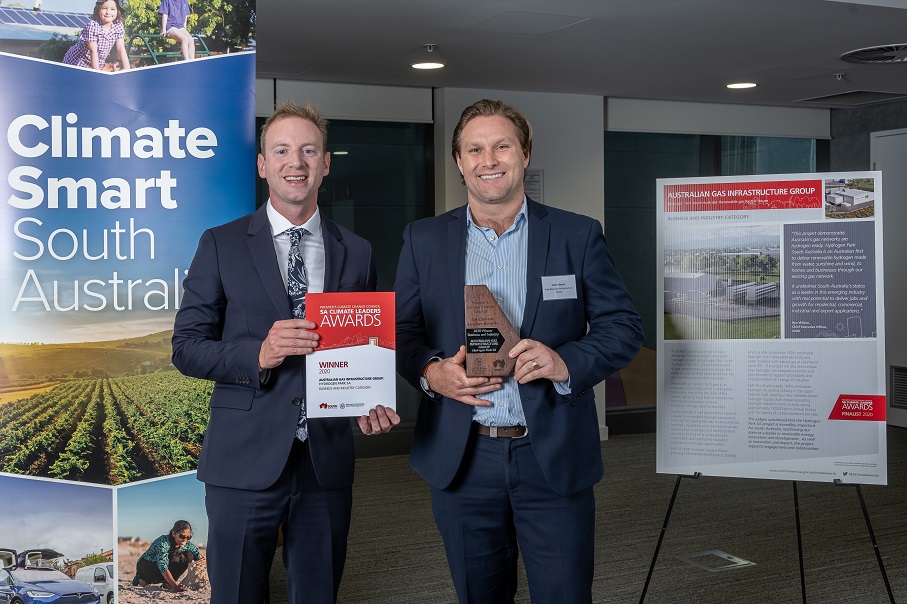
October 2020
The signing of an agreement with BOC Ltd, a subsidiary of Linde plc, was announced to install tube trailer refilling infrastructure at the site.
Hydrogen tube trailers are generally semi-trailers with hydrogen tanks that vary in length from small tubes to very large size tanks – enabling hydrogen to be road-hauled from a supply site to any destination.
BOC plans to supply industrial customers in Whyalla and Adelaide with hydrogen output from HyP SA.
The new Adelaide-based hydrogen supply chain will replace current tube trailer hydrogen deliveries to Whyalla from Victoria, saving approximately 117,000km in annual driving and 122,000 kilograms of carbon emissions per year.
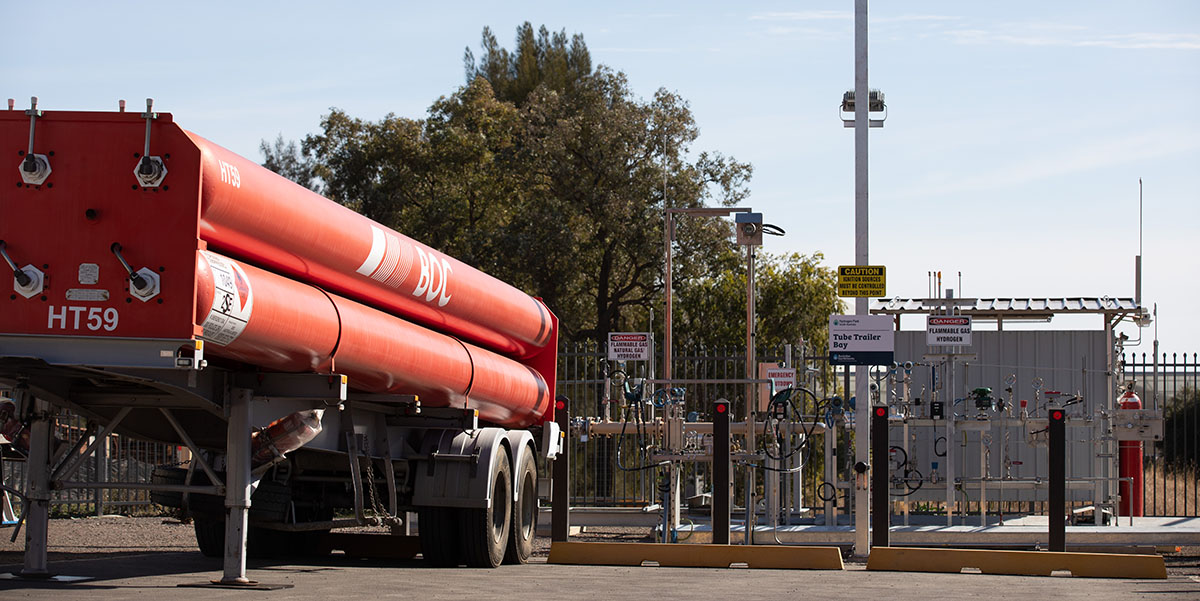
September 2020
Following delivery from Germany earlier in the year, the Siemens 1.25 MW Proton Exchange Membrane (PEM) electrolyser has begun installation and commissioning on site. The electrolyser is a key component of the electrolysis process, which employs renewable electricity to split water into oxygen and hydrogen gas, producing up to 480kg of hydrogen per day. The renewable hydrogen will then be blended with natural gas for injection into AGN's existing suburban natural gas networks.
Installation was marked by an exclusive tour of the site, with AGN staff joined by the Hon Dan Van Holst Pellekaan MP, Minister for Energy and Mining, the Mayor of the City of Marion, Kris Hanna and other key stakeholders to view construction progress. The German-engineered unit is the largest of its kind in Australia and will produce renewable hydrogen by splitting water into oxygen and hydrogen using renewable electricity.
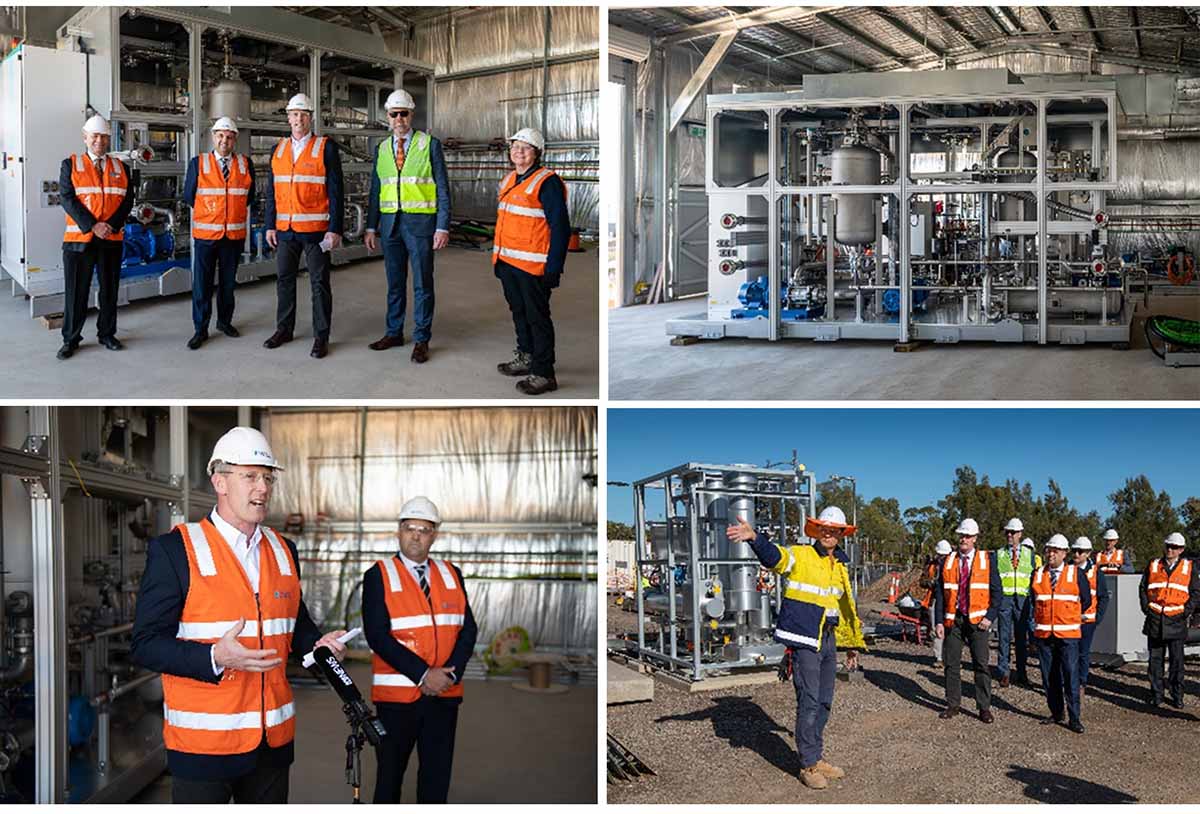
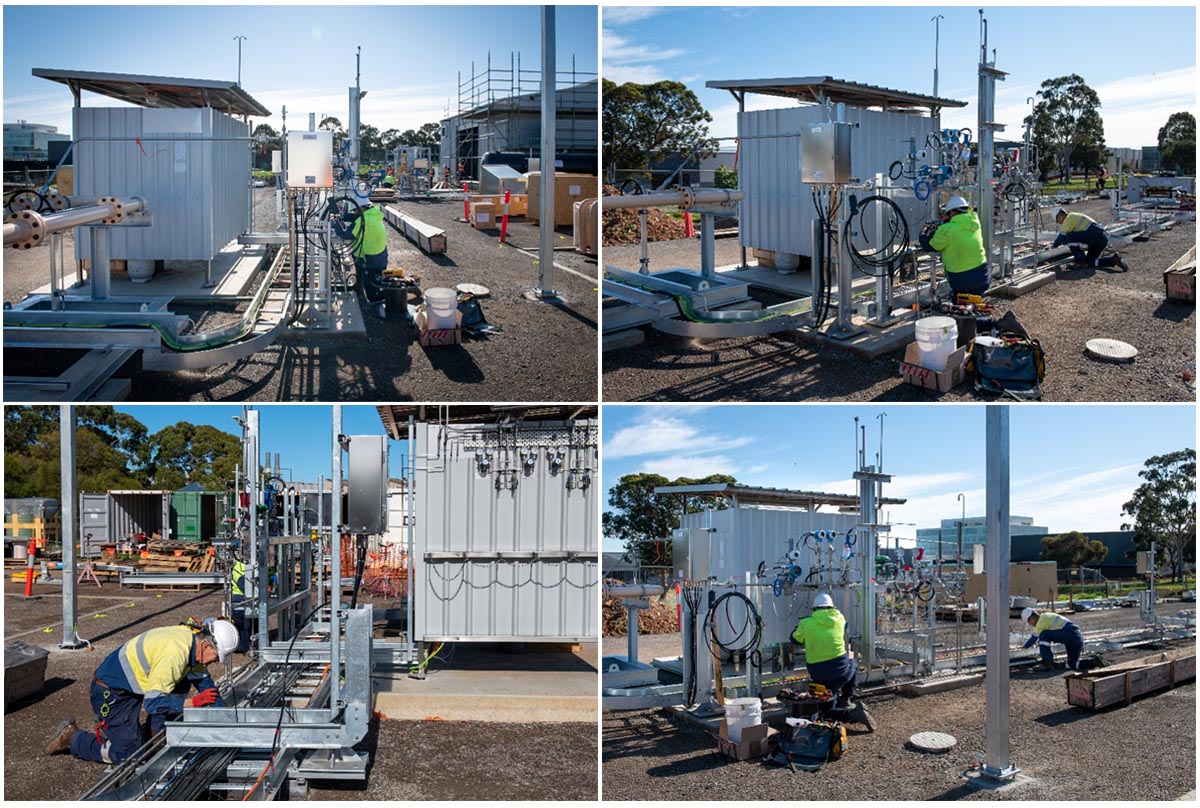
May 2020
In autumn 2020, HyP SA took delivery of a purpose-built vessel with the capacity to store approximately 40kg of hydrogen on site.
The storage vessel, which was fabricated locally by Pipetech in Adelaide, will provide important flexibility to HyP SA’s operations by allowing it to produce hydrogen at optimal times (for example when renewable electricity is cheap and abundant) for later use.
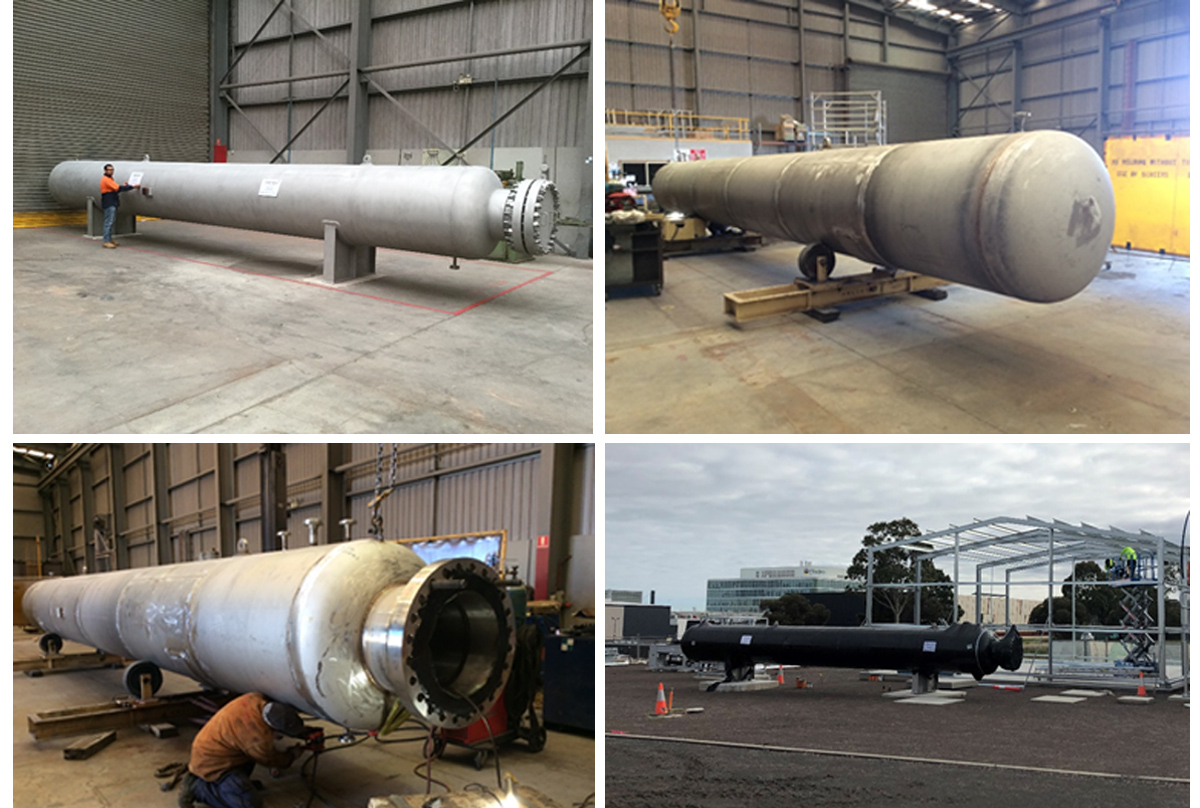
December 2019
An important milestone in the project was marked during a special event on site, where the first sod was turned to signify the beginning of construction. With the electrolyser on its way from Siemens in Germany and other plant components under construction in South Australia, the ground breaking marked that we are on track to begin hydrogen production by spring 2020.
The event was attended by South Australian Premier the Hon Steven Marshall MP and Minister for Energy and Mining, the Hon Dan Van Holst Pellekaan MP as well as more than 60 key stakeholders.
Our engineering partners GPA Engineering and Valmec will now commence a detailed schedule of construction works at the Tonsley Innovation District site.
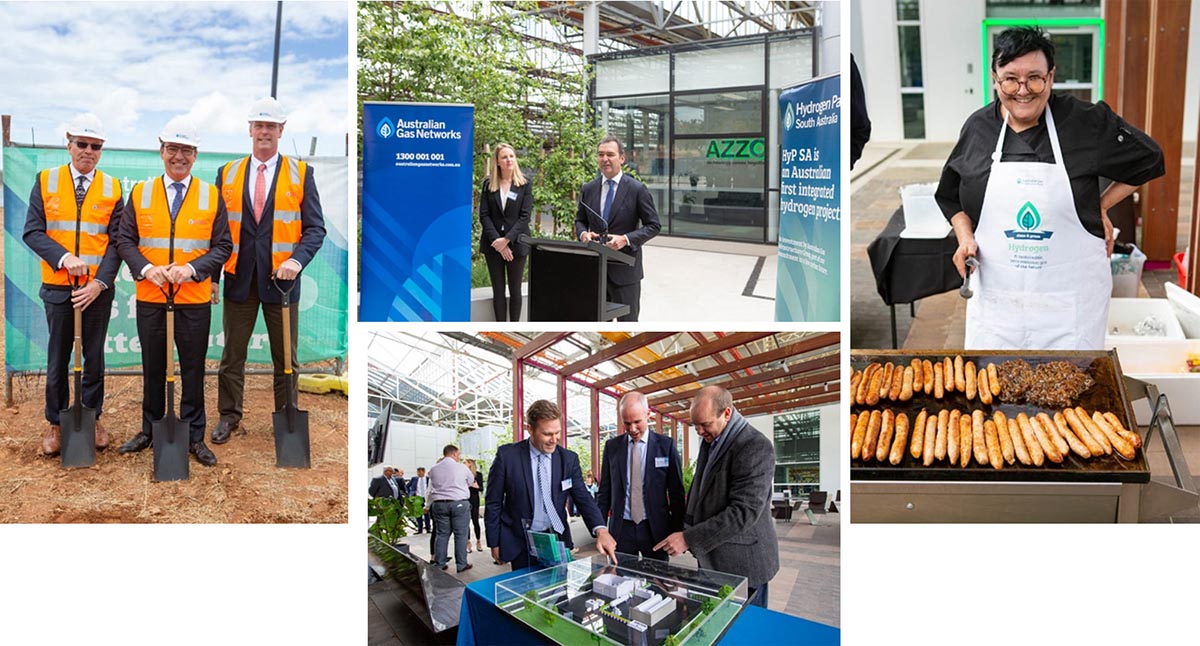
September 2019
AGN was pleased to announce the Development Application for HyP SA’s construction and operation was approved in September 2019.
The Development Application followed comprehensive consultation with South Australian Government’s cross-agency Hydrogen Regulatory Working Group that includes first responders and all other workplace safety, environmental, planning and technical regulation authorities involved in the permitting of hydrogen facilities in South Australia.
Also in September 2019, South Australia hosted the 8th International Conference on Hydrogen Safety, the world’s premier hydrogen-risk management event. AGIG was pleased to sponsor and speak at the event which provided an open platform for presenting and discussing findings and information on hydrogen safety.

August and September 2019
We have been pleased to work with our HyP SA project partner the Government of South Australia to leverage the facility to build partnerships in the supply of renewable hydrogen to new and emerging markets.
In August and September 2019, AGIG participated in inbound delegations led by Representative Lee Won-Wook of Korean National Assembly, and the University of Tokyo respectively. Visitors discussed opportunities for collaboration over lunch cooked by a locally-built barbecue fuelled by 100% hydrogen.

Need to get in touch? You can contact us to find out more about our projects or register for updates using the below details.
1300 001 001 and press option 8
Register here to receive our e-news updating on project progress and our renewable gas journey